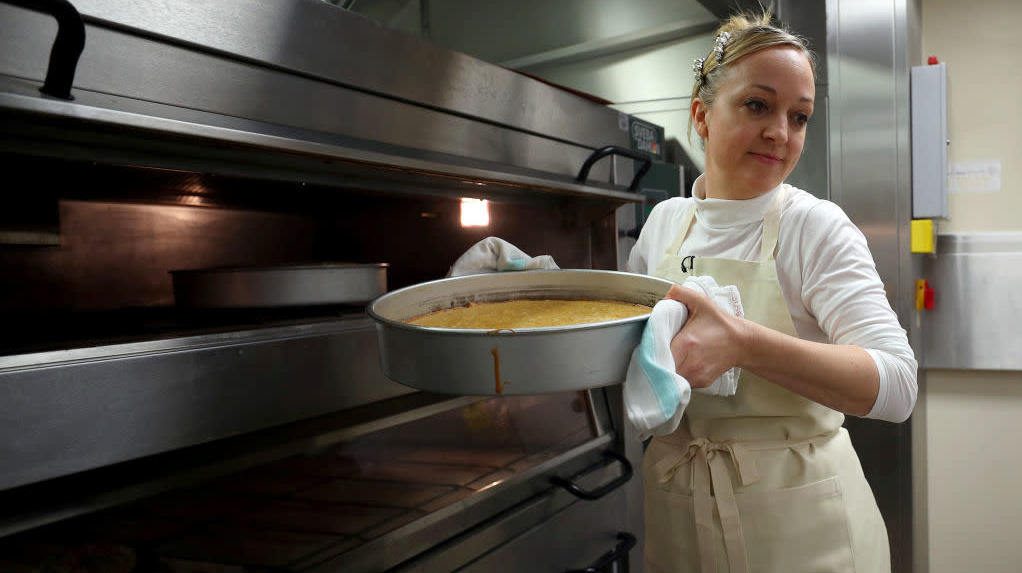Do Cakes "Sing" When They're Done Baking?
I mostly bake nowadays as a form of relaxation. Few rituals reset my head as reliably as hitting play on a long podcast and executing a predictable series of tactically satisfying tasks that a) create natural, warm aromatherapy, b) feel productive, and c) result in a delicious and shareable treat that I can bag up and bike to the door stoops of my friends. Yet for all baking's therapeutic properties, there's one step that consistently raises my blood pressure: the one-to-five-ish minute window of hedging whether or not it's time to take my cakes or bars or cookies out of the oven. After liberally spending money on ingredients, dirtying a sink of equipment and dishes, and getting sore feet from standing at the counter, nothing pisses on my zen quite like knocking down the quality of my homemade dessert a peg at the very last minute by misjudging its doneness.
Even in a precision-driven practice like baking, there's wiggle room within recipes, particularly when it comes to timing. Cookbook authors almost always offer an estimated time window but advise bakers to rely on their senses to judge doneness. I'll never turn down a tip on how to make that challenging part easier for myself. So, like Lifehacker's Claire Lower, my ears perked up during the latest series of The Great British Bake Off whenever Peter "the baby-faced assassin" Sawkins mentioned his habit of listening to his bakes.
Among the kitchen methods and techniques that have been displayed inside the show's tent over the years, cake whispering has stuck out to me as a noteworthy mix of basic chemistry and folksy hunch-ism. Since it was Sawkins who most recently served as ambassador to this practice—up to and including in the finale, where he made timing adjustments to his choux because it was "a bit too loud in there"—I reached out to him to get more information.
"It's completely on the feel of it, the intuition," Sawkins told me. "I know that a cake is really under-baked if I'm hearing it kind of boiling away, and I'm hearing it too much. I'm just looking for a gentle simmer or sound." Sawkins says that he primarily relies on the classic skewer test to determine when a cake is ready to come out of the oven, but adds that using multiple senses helps him better anticipate how the final product is going to look and taste. "You can get it to the point where you've baked it and you can not hear anything. And that's when I know it's overbaked, because I want a bit of that gentle simmer to be running. And then the carryover cooking will finish it, and make a lovely moist sponge." It's a tactic he picked up from series three winner John Whaite, then again from Val Stones in series seven. "There's no science there," says Peter. "It's just the intuition of getting the right level of moisture in the cake."
But this being baking, there is, of course, some science involved—but what is it? My usual go-to source for these sorts of questions—the Cook's Illustrated archives—dug into this a little at one point, but the method of experimentation seems... dubious:
We were skeptical, but when we hovered next to the oven door while baking a couple of cakes, we could indeed hear faint crackling sounds as the water in the batter turned to steam and escaped.
As entertaining as it is to imagine a gaggle of clipboard-holding test cooks pressing their ears up to a closed oven door, it is my understanding that this technique is employed at the very end of a cooking process, typically once you're ready to open the door and let heat and steam escape anyway—not while it's still inside. So I asked Rhonda Stewart, a certified executive pastry chef and senior instructor at Johnson & Wales University, what she thought.
"I spoke with some colleagues this morning," said Stewart, "and one said, 'If it's singing Pavarotti, then I got it. But otherwise, no.'" Whether through whipped egg whites or chemical leaveners that create carbon dioxide, cakes get their lift from air bubble molecules that expand as the cake cooks. Stewart continues, "I think it's more what they're hearing is possibly the lack of sound, meaning as those bubbles are popping [and] the carbon dioxide is released... the gasses are being released right before the final crust is formed."
That actually lines up with what Sawkins described, and it also lines up with the way cake tops become less porous as a proper crust forms. It may be a viable trick for home cooks, Stewart says, but there's one big obstacle that prevents cake-listening from being practical in commercial kitchens: "For a professional baker, I can't hear myself think in the kitchen, let alone listen to a cake." Refrigerators, mixers, blast chillers, telephones, ovens, coworkers—industrial kitchens are loud as hell.
"What we get more than the sound is actually [the cakes'] aroma," said Stewart. "I was taught by Germans who, you know, they never used a watch for anything or a timer for anything in the bake shop. We would have 20 different things going at the same time, and you had to learn what it smelled like." Stewart even ranks scent as a more reliable indicator than sight, which can be deceptive. A bread made with milk, for instance, will appear golden brown faster than its water-based counterpart, even if the bake is the same. Same goes for recipes heavy on sugar or made with chocolate, where the dark color masks the usual helpful visual cues of doneness. A little resistance to touch, Stewart notes, is also a helpful gauge. But to really bake like a pro? Let your nose make the call.
